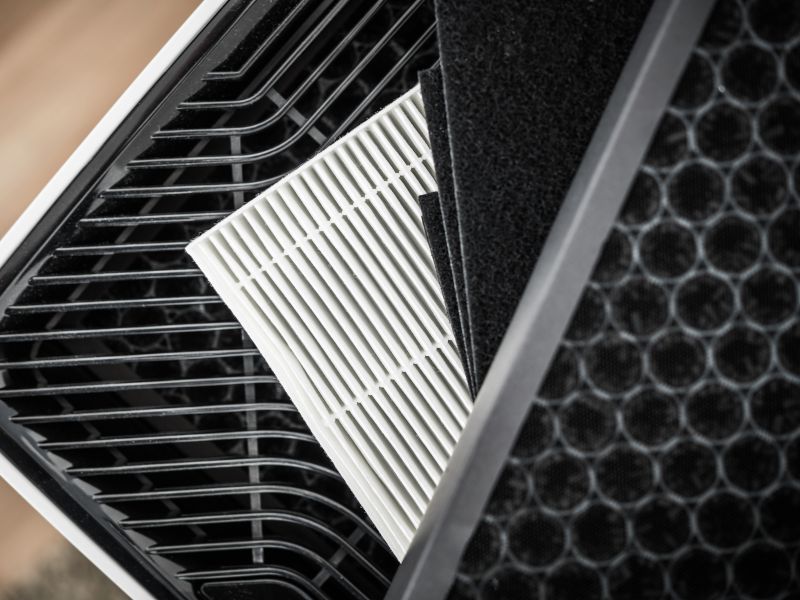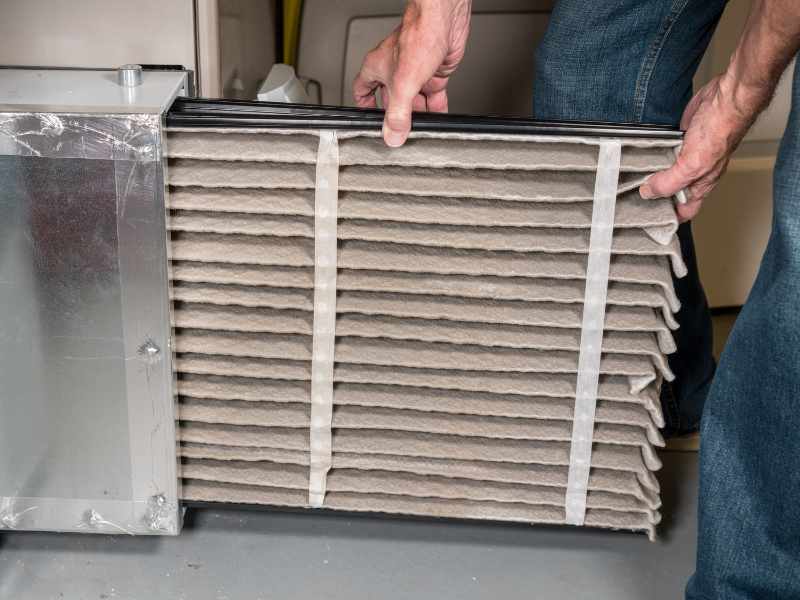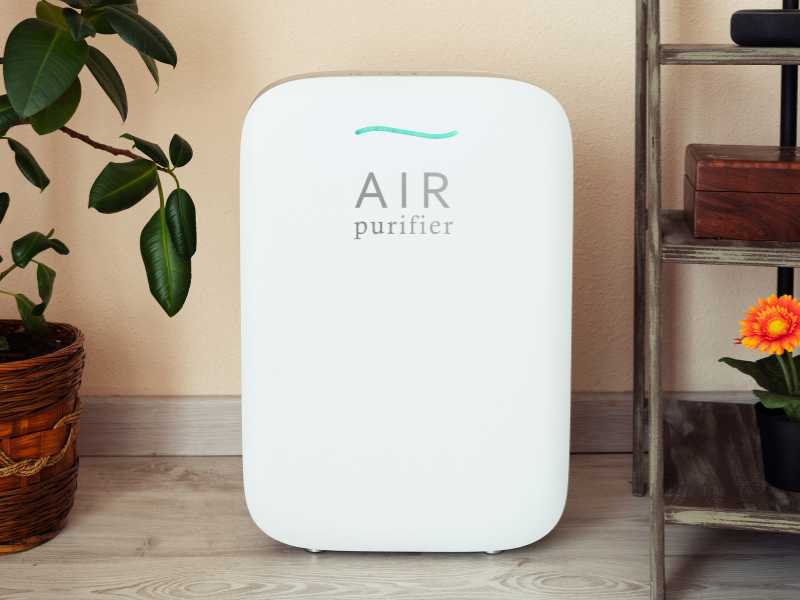Which Air Filters for Allergies Work Best in 2025?
If you’re among the 25.7% of adults suffering from seasonal allergies, air filters for allergies can dramatically reduce sneezing, itchy eyes, and congestion indoors. High-quality HEPA and MERV 11-13 filters capture up to 99.97% of allergens as small as 0.3 microns, including pollen, pet dander, dust mites, and mold spores.
This guide explores which air filters for allergies deliver the best results, how MERV ratings impact relief, and practical strategies to transform your home into an allergy-free sanctuary.
Understanding How Air Filters for Allergies Work
Air filters for allergies trap microscopic particles that trigger reactions as air circulates through your HVAC system. These filters capture pollen (10-40 microns), pet dander (0.5-100 microns), dust mite debris (5-20 microns), and mold spores (3-40 microns).
Filtration occurs through three mechanisms: interception (particles follow the airstream and contact fibers), impaction (larger particles collide with fibers), and diffusion (the smallest particles move erratically and stick to fibers). According to the American College of Allergy, Asthma & Immunology, air filters for allergies with MERV ratings of 11-13 effectively capture allergens while maintaining proper HVAC airflow.
MERV Ratings: Choosing the Right Air Filters for Allergies

MERV (Minimum Efficiency Reporting Value) ratings measure filtration effectiveness on a scale of 1-20, with higher numbers indicating superior particle capture.
| MERV Rating | Particle Size Captured | Best For | Allergy Relief |
| MERV 1-4 | 10+ microns | Basic dust only | Minimal |
| MERV 5-8 | 3-10 microns | Standard homes | Moderate |
| MERV 9-12 | 1-3 microns | Allergy sufferers | Good |
| MERV 13-16 | 0.3-1 microns | Severe allergies | Excellent |
MERV 11-13: Optimal for Most Allergy Sufferers
MERV 11-13 air filters for allergies represent the sweet spot, trapping particles as small as 1 micron, including pollen, pet dander, mold spores, dust mites, and bacteria. These filters balance exceptional filtration with proper airflow for residential systems without requiring modifications. For selection guidance, explore the best air filter for home options.
MERV 14-16: Hospital-Grade Protection
For severe allergies or asthma, MERV 14-16 filters provide hospital-grade filtration, capturing particles as tiny as 0.3 microns, including bacteria and virus-carrying droplets. However, verify your HVAC system can handle increased static pressure before installing these ultra-high-efficiency air filters for allergies.
HEPA Filters: The Gold Standard

High-Efficiency Particulate Air (HEPA) filters capture 99.97% of particles 0.3 microns or larger, making them ideal for severe allergies, asthma, or compromised immune systems.
True HEPA vs. HEPA-Type:
- True HEPA: Certified to capture 99.97% of 0.3-micron particles, meeting U.S. Department of Energy standards
- HEPA-Type: Lower efficiency (85-90%), not certified to true HEPA standards
Most residential HVAC systems cannot accommodate true HEPA air filters for allergies due to airflow restriction. Install MERV 11-13 pleated filters in central HVAC systems, and reserve true HEPA filters for portable air purifiers in bedrooms and living areas. Learn more in our comprehensive HVAC filters guide.
Types of Air Filters for Allergies
Pleated Filters
Pleated air filters for allergies feature folded material, creating increased surface area for superior particle capture while maintaining reasonable airflow.
Pros: Available in MERV 8-13 ratings, affordable, fit standard systems, last 3-6 months
Cons: Require regular replacement, less effective for ultra-fine particles below 1 micron
Electrostatic Filters
Electrostatic air filters for allergies use static electricity to attract particles. Available in washable or disposable versions.
Pros: Washable versions reduce costs, are effective for dust and pollen, environmentally friendly
Cons: Lower efficiency than MERV 11-13 filters, require monthly cleaning
Activated Carbon Filters
While carbon filters excel at removing odors and VOCs, they’re not primarily designed as air filters for allergies. However, they complement HEPA or pleated filters by removing chemical triggers, including cleaning product fumes, perfumes, or smoke odors that exacerbate allergic reactions.
How Often to Replace Air Filters for Allergies
Replacement frequency directly impacts how effectively air filters for allergies protect indoor air quality.
| Living Situation | Replacement Frequency |
| No pets, mild allergies | Every 90 days |
| Pets or moderate allergies | Every 60 days |
| Multiple pets or severe allergies | Every 30-45 days |
| Construction or renovation | Every 20-30 days |
For detailed guidance, visit how often to change HVAC filters. Regular HVAC filter replacement ensures continued allergen-free air.
Signs Your Filters Need Replacement

Replace air filters for allergies immediately if you notice:
- Visible dust accumulation on the filter surface
- Increased allergy symptoms despite filter use
- Reduced airflow from vents
- HVAC system running longer cycles
- Dusty surfaces shortly after cleaning
Maximizing Air Filters for Allergy Effectiveness
Proper Installation
Ensure air filters for allergies fit snugly without gaps. Check arrows on the filter frame point toward the blower motor, indicating correct airflow direction.
Whole-Home Air Quality Strategies
Complement air filters for allergies with these enhancements:
- Maintain 30-50% relative humidity to discourage dust mites and mold
- Vacuum with HEPA-equipped units twice weekly
- Use allergen-proof covers on mattresses and pillows
- Place the best air purifiers in bedrooms
For comprehensive strategies, review how to improve indoor air quality.
Professional Testing
Consider a home air quality test to identify specific allergen sources and concentrations, allowing targeted filter selection.
Standalone Purifiers vs. HVAC Air Filters for Allergies
HVAC System Filters
Pros: Filter entire home, cost-effective, works continuously when HVAC operates
Cons: Only works when the system runs, may not achieve true HEPA filtration
Portable Air Purifiers

Pros: True HEPA filtration available, target specific rooms, operate independently
Cons: Only filters the immediate vicinity, requires multiple units for coverage
The Optimal Combination
For maximum relief, install MERV 11-13 air filters for allergies in your HVAC system while using true HEPA air purifiers in bedrooms and primary living spaces.
Air Filters for Allergies and Asthma
Asthma sufferers require particularly effective air filters for allergies since respiratory triggers can cause dangerous attacks. Focus on capturing asthma triggers: dust mites, mold spores, pet dander, pollen, and smoke particles.
Choose MERV 13 or HEPA air filters for allergies certified by the Asthma and Allergy Foundation of America. Maintain strict replacement schedules and avoid filters with added fragrances.
Cost-Effectiveness Analysis
| Filter Type | Initial Cost | Annual Cost | Allergy Relief |
| Fiberglass (MERV 1-4) | $2-$5 | $24-$60 | Minimal |
| Pleated (MERV 8-10) | $8-$15 | $32-$60 | Moderate |
| Pleated (MERV 11-13) | $15-$30 | $60-$120 | Excellent |
| HEPA (standalone) | $30-$80 | $60-$160 | Superior |
Quality air filters for allergies reduce medical costs, extend HVAC lifespan, improve energy efficiency, and increase productivity through fewer sick days and better sleep.
Taking Action on Air Filters for Allergies
Choosing effective air filters for allergies transforms your home into a healthier sanctuary. By selecting MERV 11-13 pleated filters for HVAC systems, adding true HEPA air purifiers in key rooms, and maintaining proper replacement schedules, you’ll experience dramatic relief.
Ready to breathe easier and eliminate allergy triggers? Contact the indoor air quality experts at Callidus Air today for personalized recommendations on the best air filters for allergies for your needs. Our team specializes in comprehensive air quality solutions delivering real, measurable relief. Start your journey to cleaner, healthier indoor air now!
Frequently Asked Questions About Air Filters for Allergies
What MERV rating is best for air filters for allergies?
For most allergy sufferers, air filters for allergies with MERV 11-13 ratings provide optimal results. These filters capture particles as small as 1 micron, including pollen, pet dander, dust mites, and mold spores—the most common indoor allergens. MERV 11-13 filters balance exceptional filtration with proper airflow for residential HVAC systems. Individuals with severe allergies may benefit from MERV 13 specifically, while those with mild symptoms find MERV 11 sufficient. Always verify your HVAC system can handle your chosen MERV rating to prevent airflow restriction and motor strain.
Can air filters for allergies help with pet dander?
Yes, high-quality air filters for allergies effectively capture pet dander. Pet dander particles range from 0.5-100 microns, with most falling in the 2-10 micron range. MERV 11-13 pleated filters trap the majority of pet dander particles, while true HEPA filters capture 99.97% including the finest particles. For homes with multiple pets or severe pet allergies, combine MERV 13 HVAC filters with HEPA air purifiers in rooms where pets spend most time. Replace filters every 30-60 days in pet-owning households as dander accumulates quickly, reducing filtration efficiency.
How often should I change air filters for allergies?
Replacement frequency for air filters for allergies depends on household conditions. Standard recommendations: every 90 days for homes without pets and mild allergies; every 60 days with pets or moderate allergies; every 30-45 days with multiple pets or severe allergies. Monitor filters monthly and replace sooner if visibly dirty or if allergy symptoms increase. During high pollen seasons (spring and fall), replace filters more frequently. Homes undergoing construction should replace filters every 20-30 days. Consistent replacement maintains maximum allergen capture and prevents trapped particles from recirculating.
Are HEPA filters better than MERV 13 for allergies?
True HEPA filters technically outperform MERV 13 air filters for allergies, capturing 99.97% of particles 0.3 microns or larger versus MERV 13’s 85-95% efficiency. However, most residential HVAC systems cannot accommodate HEPA filters due to airflow restriction. The practical solution: use MERV 13 pleated filters in your central HVAC system for whole-home filtration, and add true HEPA air purifiers in bedrooms and primary living areas for targeted protection. This combination provides comprehensive allergen removal without stressing your HVAC system. For severe allergies, this dual approach delivers optimal results.
Do air filters for allergies help with seasonal allergies?
Absolutely. Air filters for allergies significantly reduce seasonal allergy symptoms by capturing airborne pollen before it circulates throughout your home. Pollen particles typically measure 10-100 microns, well within the capture range of MERV 11-13 filters. During peak pollen seasons, keep windows closed and run your HVAC system on “auto” mode to continuously filter air. Install fresh MERV 11-13 filters before allergy season begins (early spring and fall), and replace them mid-season if pollen counts remain high. Combine quality filtration with air purifiers, regular cleaning, and humidity control for maximum seasonal allergy relief and improved breathing comfort year-round.

